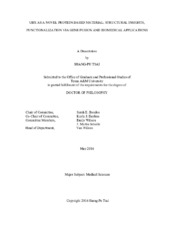| dc.description.abstract | Compared to conventional synthetic polymers, protein-based materials have unique advantages, such as useful mechanical properties, biocompatibility and biodegradability. Protein-based materials have the potential to be customized for a variety of applications, for example, biosensor, tissue engineering scaffolds and drug delivery vehicles. All these applications require optimizing the mechanical properties and adding functional proteins. Current methods to produce and functionalize protein-based materials are often performed in harsh conditions, which is harmful for the functional molecules. Our laboratory discovered a protein-based biomaterial made from the Drosophila protein, Ultrabithorax (Ubx). Ubx protein rapidly self-assembles into material in mild aqueous buffers. This work explores the possible applications of Ubx materials, by extending the capacity to engineer the mechanical and functional properties of these materials.
Our first objective of this work was to investigate the structure and assembly of Ubx materials. We found the strength of Ubx materials is due to dityrosine bonds and located the amino acids that participate in these bonds. Tyrosine mutagenesis can decrease the strength of these materials, allowing the mechanical properties to be precisely tailored for a variety of applications.
Our second objective was to study how the physicochemical properties of appended proteins impact the production of monomer and assembly of Ubx materials. By fusing proteins with a variety of physicochemical properties to Ubx. We demonstrated that the appended proteins dictate the solubility and purification yield of the corresponding protein fusions. Surprisingly, all protein fusions self-assemble equally well to produce materials with similar morphologies. We concluded that a far wider range of proteins can be successfully incorporated into elastomeric protein-based materials than originally anticipated.
Finally, we used Ubx materials as tissue engineering scaffolds. We found VEGF-Ubx materials trigger corresponding signaling and stimulate migration and attachment of endothelial cells, proving that Ubx material can deliver appended functional molecules to attaching cells in vitro.
In summary, this research explores a new way to control the mechanical properties of protein-based materials, reveals the great potential of Ubx materials as a system for functionalizing materials, and demonstrates the feasibility of using Ubx materials as bioactive tissue engineering scaffolds. | en |


